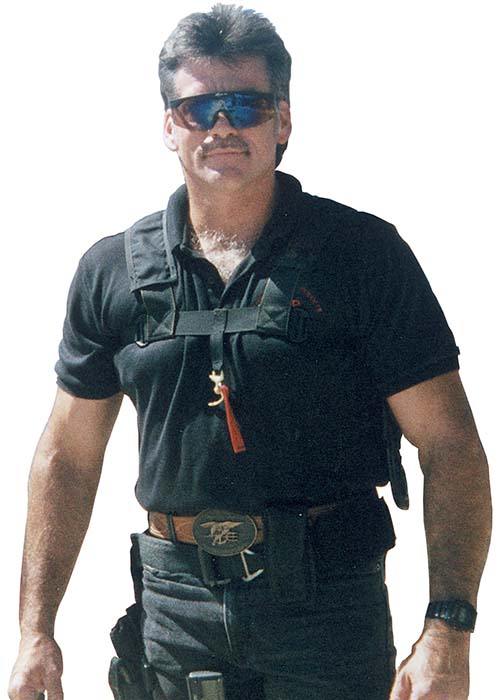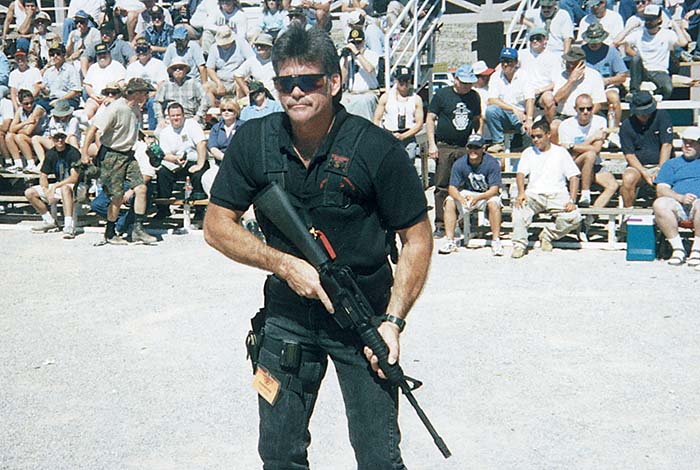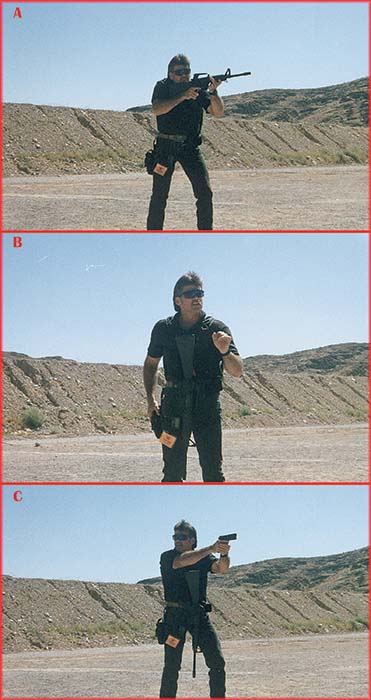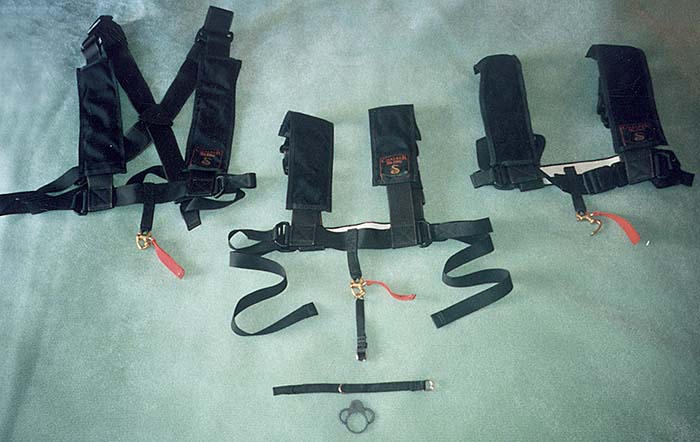The three basic models of the Chalker Sling are (L-R) The Crossback, The Elastic Back, and The Adjustable Front. In the front of the photo are a weapons lanyard and a CAR-15 adapter.
By Matt Smith
The Chalker Sling is one of the finest weapon slings available to small arms shooters today. The sling was developed by Dennis “Snake” Chalker, a plankowner of both SEAL Team Six, the Navy’s hostage rescue team, and Red Cell, which were formed under the leadership of Dick Marcinco. The idea for the sling came as a result of experiences Denny had during worldwide deployments with Navy Special Forces. The Teams worked with a variety of weapons, including the M16 family, the MP5 family, the M14 rifle, and shotguns including Benellis and Remingtons. Denny originally designed the Sling in 1984 so that it could be used with any required weapon, but waited until after his retirement in 1997 to bring it to the commercial market through Metro Tactical Products.

In Grenada, Denny carried a two-point sling on his M-4 with a carabiner hooked on his “H” harness. The weapon would swing around and hit him on the shin and hung to one side. When he returned, Denny knew he wanted something better and designed the prototype Chalker Sling. The original sling was sewn up by Denny in the parachute riggers loft. Denny took two straps off of an Army web belt butt pack to make shoulder straps for the new sling. Adjustable buckles were added to the rear of each strap. The shoulder straps were then sewn together in the back on a length of elastic strapping. A single piece of webbing was sewn on the front to connect to the bottom of the shoulder straps. A runner was attached to the front center of the sling, which hung down approximately eight inches. A Swedish reserve static line (RSL) shackle was looped in at the bottom of this runner. The key to the reliability and success of the sling rests with this shackle. This sling was used on various military operations, including Panama and El Salvador, in a variety of environments including underwater operations, urban warfare, jungle warfare, during hostage rescue situations, helicopter inserts, vehicle inserts, boat inserts, swim inserts and the required extracts. The new sling evolved and was proven as it was tested in both training scenarios and the real world. The sling is available in a variety of commercial versions today.
There are three basic models of the Chalker Sling. Models include the cross back model for smaller framed individuals and women, the elastic back model which can fit over body armor, and the adjustable front model for extra large individuals. A second generation of slings is now in production, which includes moveable shoulder straps in place of fixed, sewn shoulder straps. This allows the wearer to slide the straps into the most comfortable position for each operation. The cross back model can now be obtained with a sliding cross junction for added flexibility in lieu of the sewn back. Options available include the weapon catch, which secures the front of the weapon, and can be installed on either side of the sling in the high port position. Velcro is placed over either the forearm or the barrel depending on where you want the weapon to sit. When the weapon is needed, the Velcro is peeled back to release the front of weapon. The newest option consists of cowhide replacement shoulder straps. These straps hold butt stocks more firmly to prevent slipping during firing and are excellent for maritime operations as well.
When the sling was first developed, Denny used the elastic strap of his leg pouch or a bungie cord to secure the loose end of the weapon to his leg and keep it from moving until needed. When it was time to raise his weapon, Denny would push down on the elastic and pull up on his MP-5 or release the bungie on his M-16. BlackHawk Industries (which was founded by Mike Noell, a former Navy SEAL, who worked with Denny) now offers two versions of their weapons catch to secure the weapon in conjunction with the sling. The two models include a rigid type and a flat flap style for your belt.
Denny developed the Chalker Sling in order to be ready to carry a variety of weapons depending on what the tactical situation called for. In the Teams, missions might require a submachine gun, an M16, a shotgun, or a sniper rifle. It was time consuming to rig a different system for sling carry before each mission. Denny wanted to design a sling that would work with any weapons that may be required. This was how the Chalker Sling was born. A universal weapons lanyard is attached to each weapon with the proper standoff for that weapon. By each weapon having its own lanyard, the operator can select from a variety of firearms, which have been fitted with a lanyard and attached the chosen weapon to the single latch point within a matter of seconds. When the situation is over, a single pull of the release tab releases the weapon so that it may be properly stored. The proper stand off allows the firearm to be comfortably carried and secured in the weapons catch when not required. Weapons may be worn with gas masks and can be brought into action quickly in either the prone or standing position with the ability to switch from strong side to weak side with no interference.
For the tactical shooter, each tenth of a second may mean the difference between life and death. Speed is very important, but body motions have to be smooth as well. According to Denny, there is nothing worse than performing a dynamic entry and having your weapon get caught up in your sling as you extend it for use. In a methamphetamine lab or chemical environment, a gas mask must be worn. A three-point sling, because of the positioning of the straps, may break the seal of your gas mask as you extend your weapon and expose you to hazardous chemicals. The Chalker Sling overcomes this liability by hanging evenly over each shoulder with a central weapon attach point. A three-point sling, when worn for prolonged periods of time, will dig into your shoulder, causing discomfort and fatigue. The Chalker Sling is designed to spread the weight of weapons evenly across both shoulders, as well the back. The Chalker Sling is also compatible with body armor. It may be worn over the body armor and tactical vest or over the body armor and underneath the tactical vest with the tab running through it. Today, conservation officers and patrol officers wear the sling over their body armor and underneath their duty shirt, which conceals the sling until needed. One or 2 buttons are opened to reveal the lanyard which can be quickly attached to the weapon for use. The primary feature of the sling is the single attach point and quick release system. Denny states that the commercial version of his sling is much more comfortable than his original version.

Another strong point for the Chalker Sling involves changing weapons in the tactical environment. If your primary weapon (rifle or submachine gun) becomes disabled, and you have to shift to your secondary weapon (pistol) a traditional three-point sling may impede this transition or dislodge your gas mask. When wearing the Chalker Sling, when you release your primary weapon it will hang straight down. This allows both of your hands to access your secondary weapon. In close quarters situations, you want your primary weapon down and out of the way so that you can use your weak hand to defend, to block, or to push as you go to your secondary weapon.
A limitation of a traditional three-point sling comes into play when an opponent grabs your weapon. In this situation, you either win or you get choked out. If the opponent is dressed in slick attire, and you are wearing a variety of gear that he can grab, he has the advantage. With the Chalker Sling, you can release your primary weapon to your opponent and draw your secondary to use against him. This will prevent you from getting into a wrestling match with your opponent. At that point, you may use deadly force against him if necessary, as he is now armed with your weapon. In the time it takes the opponent to turn your primary weapon around towards you, you can take a shot with your secondary weapon.
The Chalker Sling is an excellent tool for those assigned to sniper duty. Once your rifle is attached to the sling, you do not have to remove it as you get in or out of the prone shooting position. Even if you have to crawl with your weapon, the Chalker Sling allows you to do this with no impediments or adjustments. If wearing the traditional three-point sling, you must turn the weapon around to your backside to crawl. In this position, your weapon is not immediately accessible, as it would be if wearing the Chalker sling where the weapon remains in front of you at all times. When attaching your weapon, you simply place the “D” ring of the universal weapons lanyard into the shackle of the sling and snap it in. The shackle is rated for 800 pounds of pull and can handle any small arms weapon, which you may need to carry.

Although the Chalker Sling was developed for military/tactical use, many of its features benefit the recreational shooter as well. By using the Chalker Sling, you eliminate the need for a different sling for each rifle, shotgun or sub-machinegun you own. This is possible due to the attachment of inexpensive lanyards to each weapon. The Chalker Sling is more comfortable than traditional slings due to the way it distributes weight over both shoulders and the back. One of Denny’s first recreational customers was a group of 70 duck hunters from a North Carolina gun club. They saw the benefit of having their shotguns close at hand in the duck blind and still being able to sip coffee and wait for the birds to come into view. Kevin Dockery, the co-author of Denny’s autobiography Snake – One Perfect Op, wears a Chalker Sling to hold his camera or binoculars while waiting to take photographs. Participants in three-gun matches have found it gives them an edge in shooting competitions. Even Hollywood likes the Chalker Sling. Arnold Schwarzenegger used a Chalker Sling in the final action sequence of his movie End of Days as he strapped on an MP5/M203 sub-machinegun and grenade launcher combination.
You can find out more about the Chalker Sling by contacting the distributor Metro Tactical Products, a law enforcement supply company located in Corona, CA. Metro Tactical also produces the Bang Pole for the safe deployment of diversionary devices used by law enforcement and correctional institutions. Other products carried and recommend include Emerson knives, G, G & G weapon mounts, Ridgeline concealed jackets, Vang shotgun compensators , and Pro Ears hearing protection. Denny has a website for his Corporation, DSC Inc. at snake-chalker.com which includes information on his personal history, movie credits, his book The United States Navy SEALS Workout Guide, and tactical training.
Metro Tactical Products
P. O. Box 6633
Corona, CA 91718
Ph. (800) 735-7030
Fax (909) 737-9131
E-mail: metro1097@aol.com
Website: www.metrotactical.com
Denny “Snake” Chalker, Inc.
PMB 34
2514 Jamacha Road, # 502
El Cajon, CA 92019
Ph. (800) 735-7030
Fax (619) 670-0776
Website: www.snake-chalker.com
| This article first appeared in Small Arms Review V3N9 (June 2000) |











